Canon PowerShot A1100 IS
-
-
Written by Gordon Laing
Intro
The Canon PowerShot A1100 IS is a 12.1 Megapixel compact with a 4x optical zoom, and a 2.5in LCD screen backed up with an optical viewfinder. Launched in February 2009, it replaces the 10 Megapixel A1000 IS and sits in the middle of Canon’s A range of compacts now positioned to appeal to the point-and-shoot user on a budget.
The A1100 IS is, above all, a very affordable compact, but that doesn’t mean it’s short on features. It benefits from all of the new technologies brought in with Canon’s DIGIC 4 processor including scene recognition and face detection, and can shoot 640×480 pixel movies at 30 frames per second.
The A1100 is proving to be a very popular model, but competition at this end of the market, where compacts are often bought as gifts as well as for personal use, is intense. Manufacturers are still vying to outdo each other in terms of pixel counts and features. But as we’ve seen with models like Sony’s 12.1 Megapixel Cyber-shot DSC-W220, higher image resolution can carry a price in terms of reduced image quality.
We’ve compared the PowerShot A1100 IS with another very popular budget compact, the Nikon COOLPIX L20. These two compacts look uncannily alike and are aimed at the same sector of the market – cost-conscious casual snappers – but despite their similar appearance there’s plenty to set them apart in terms of both specifications and performance. Read on to see how the Canon PowerShot A1100 IS fared in our tests and how it compared with the Nikon COOLPIX L20.
The PowerShot A1100 IS body shape is little changed from that of the A1000. The squarish body evolves into an organic bulge on the right providing a comfortable curved surface that fits nicely into the palm of your hand. The original two tone colour scheme has been toned down to provide a more subtle look in a choice of three colour schemes, blue, pink or silver.
Though not exactly bulky, the PowerShot A1100 IS is at the larger end of the compact size spectrum: it’s jacket-pocket or bag-sized, but not something you’d be comfortable with in your jeans. At 155g without the batteries (or around 200g with a pair of AAs) it’s reasonably light though.
The positioning of the mode dial on the top means your thumb has a convenient resting place on the rear panel in a recessed dip that covers the speaker. In all it’s a very comfortable camera to hold and operate – and with it’s lustre finish it looks good too.
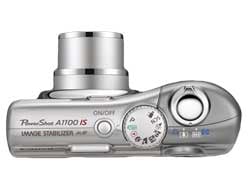 |
The on/off button is situated right in the middle of the top panel. To the right of it you’ll find the mode dial and then, in the middle of the ‘bulge’, the shutter release button with its zoom rocker surround. With its knurled edge the mode switch looks and feels like a plastic bottle top, which is unfortunate, but it has a very positive click action and you can easily switch between the three auto modes, various scene presets and movie mode using just your thumb. Because the mode dial protrudes slightly from the rear body we found it frequently moved when the camera was put into and taken out of a pocket, which was a little bit irritating, but a fairly minor nag.
|
On the rear panel is the control disc used to navigate menus that doubles up as a single-click selector for exposure compensation, flash, self-timer and macro focussing. This is flanked by four buttons, two above for face selection and direct printing, and two below to change the display overlay and enter the main menus. The Direct Print button can be configured to provide one-touch access to a setting of your choice; options include ISO, white balance, custom white balance, red-eye correction, Digital tele-converter and i-Contrast enhancement. For a budget point-and shoot compact, the PowerShot A1100 IS certainly isn’t short of opportunities to customise.
A small button at the top of the rear panel switches the camera into playback mode – to return to capture mode you can either press it again or apply first pressure on the shutter release.
Access to the battery compartment and SD card slot is via a spring-loaded door in the bottom panel. There’s no retaining catch, so if you turn the camera upside down with door open the batteries fall out which is convenient if you want to change them. The door is a tight snug fit and, like everything else about the PowerShot A1100 IS feels well designed and nicely engineered. The plastic tripod thread is mounted centrally just to the right of the lens.
The PowerShot A1100 IS has a built-in flash unit located above and to the left of the lens. The manual says it has a maximum range of 4 metres at the wide angle end of the zoom range and 2 metres at the telephoto end and we found this to be reasonably accurate, with good coverage and only slight fall off in illumination at the edges. Like other Canon compacts that use AA batteries, the flash was quite slow to recharge. After it fires, the LCD screen turns off and one of the indicator LEDs flashes orange while it recharges – this can take up to 8 seconds. The flash can be turned off, forced on, activated automatically in low light, or used in slow synchro mode for fill-in illumination.
Like its higher-end stablemate, the PowerShot A2100 IS, the A1100 IS takes AA batteries. Depending on your view, this is either a curse or a blessing. You might prefer having a dedicated battery that’s for your camera and nothing else and not having to cannibalise your TV, Wii, or alarm clock for camera batteries. On the other hand the convenience of being able to pop in a couple of AA’s has a lot to recommend it.
The CIPA (Camera Imaging Products Association) standard figures for the Powershot A1100 IS using the LCD panel are 140 shots with alkaline batteries, and 350 shots with NiMH batteries. That’s how many photos you’ll be able to take with ‘typical’ use of the zoom and flash. Not nearly as good as the Nikon COOLPIX L20, but the PowerShot A1100 IS also gives you the option of turning the LCD off and relying on the optical viewfinder. Do this and you’ll be able to squeeze out 430 (700 with NiMHs) shots before needing to replace the batteries – that’s considerably more than any LCD-only compact can manage.
Canon PowerShot A1100 IS coverage wide |
Canon PowerShot A1100 IS coverage tele | |
 | 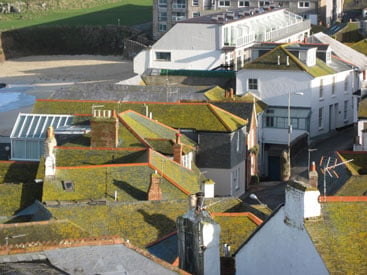 | |
| 6.2-24.8mm at 6.2mm (35mm equivalent) | 6.2-24.8mm at 24.8mm (140mm equivalent) |
The PowerShot A1100 IS lens is an optically stabilised 4x zoom with a range of 6.2-24.8mm – 35-140mm in 35mm terms. That’s a respectable zoom range for a camera in this price bracket, and while there’s unsurprisingly no 28mm wide-angle, the 35mm equivalent is still adequate for capturing large group shots or landscapes.
On power-up the lens extends by around 25mm and the camera is ready for action in around two seconds. The motor covers the entire zoom range smoothly and relatively quietly, emitting a faint buzz, in about a second and a half. The zoom has only one speed and we managed to nudge it through seven discrete steps.
The image stabilisation system employed in all Canon compacts with the IS suffix is an optical system. On the PowerShot A1100 IS you can turn it off, have it operate continuously, or activate it with a half-press of the shutter release. There’s also a panning mode which confines stabilisation to the vertical axis. See the Blurring Action tutorial at our sister site DSLR Tips for an example of how you might use this.
Canon PowerShot A1100 IS: IS off / continuous | ||
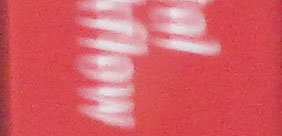 | 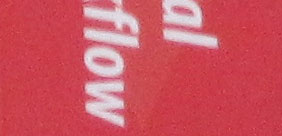 | |
100% crop, 6.2-24.8mm at 24.8mm, 1/15, 400 ISO, IS off |
100% crop, 6.2-24.8mm at 24.8mm, 1/15, 400 ISO, IS on | |
The crops above are from shots taken with the PowerShot A1100 IS with the lens set to its maximum zoom length of 24.8mm (140mm equivalent). In Program auto mode with the sensitivity set to 400 ISO the camera selected an exposure of 1/15 of a second at f5.6.
The crop on the left is from a shot taken with IS turned off, the one on the right from a shot with IS set to continuous. As you can see, the PowerShot A1100 IS has successfully eliminated the effects of camera shake at an exposure of 1/15 of a second. At a focal length of 140mm the slowest shutter speed at which you’d ordinarily expect to get a sharp picture without stabilisation is around 1/140 of a second, according to the ‘one over the focal length’ rule of thumb. The PowerShot A1100 IS successfully manages to improve on that by around three stops.
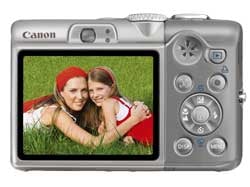 |
The PowerShot A1100 IS uses Canon’s Face AiAF autofocussing. This detects when faces are in your shot and automatically sets the focus, exposure and white balance. Face AiAF can detect up to 35 faces, identifying a main subject on which to focus. You can use the Face Select button on the back panel to cycle through all faces in the frame and select the one you want to focus on.
Canon’s Face AiAF was improved with the introduction of the DIGIC 4 processor used in the PowerShot A1100 IS, and for people shots it really makes a difference. Although in very low light conditions it can struggle to identify and track faces, mostly it works quickly and efficiently to get the focus right without you having to think about it.
If there are no people in the frame, the PowerShot A1100 IS defaults to nine-area autofocus, identifying and locking focus selecting from nine rectangular regions in the central portion of the frame. Again it’s quick and efficient, usually taking a fraction of a second before the green LED and double-beep signals that the focus is locked and the camera ready to shoot.
The PowerShot A1100 IS provides one more focussing option which uses only the central AF region and this can be further reduced to provide an even narrower central AF region. As long as half-pressure is maintained on the shutter release the focus remains set until you release it, so having focussed on an object you can re-compose your shot before shooting. There’s also a autofocus lock (AFL), activated by pressing the right control disc button, which locks the focus for a single shot even if you don’t maintain pressure on the shutter release.
The PowerShot A1100 IS has a 2.5in LCD screen with 115k pixels. Most LCD panels these days pack in 230k pixels and the A1000’s lack of resolution shows: it looks a bit dotty and doesn’t display fine detail very well. That, of course has no bearing whatsoever on the quality of the images and for composing and previewing shots the LCD screen is adequate. On the upside, the camera automatically rotates photos to make full use of the screen whether they are portrait or landscape format, so none of its limited resolution goes to waste.
There’s also a small, but very useable optical viewfinder. While this doesn’t quite display the full image area it comes in very handy in bright sunlight, when the LCD panel is difficult to see. You can also switch off the LCD panel and use it to conserve battery power. Next to the optical viewfinder on the right are two LEDs. These glow or blink to tell you that the focus has (or hasn’t) been set, when a slow shutter speed may result in camera shake and when the camera is writing image data to the card.
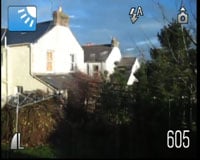 |
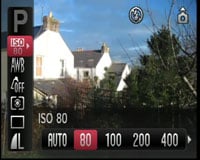 |
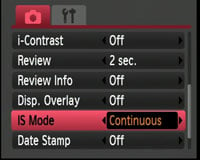 |
All of the important, or at least the most commonly used, menu options on the PowerShot A1100 IS can be accessed quickly and easily by pressing the Func Set button in the centre of the control disc. This activates a menu overlay with settings displayed in a single column on the left of the screen and associated options displayed in a row along the bottom.
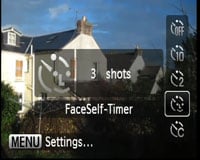 |
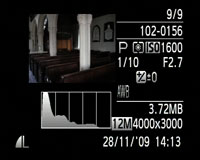 |
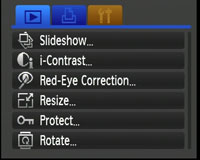 |
|
Available options will depend on the shooting mode. The Func Set button doesn’t function in Easy mode and in Auto mode you can change only the image size and compression. In Program mode you get access to ISO, white balance, colour presets, metering mode, continuous shooting and image size and compression settings.
The menu proper is divided into two tabs; the first of these provides access to shooting settings including digital zoom, flash, AF-assist beam, display overlays (grid lines, a 3:2 overlay, or both), and date stamp which permanently stamps the date and time onto your photos. The second contains less commonly used camera settings like speaker volume, LCD brightness, file numbering options, auto rotate, date and time setup and power saving options.
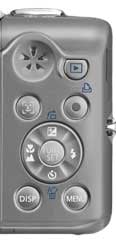 |
In playback mode the main menu provides the same camera setting tab as in capture mode together with two further tabs. One provides slideshow and basic image editing tools such as i-Contrast dynamic range enhancement, red-eye reduction and resizing, the other has direct print options.
The Func Set button has no function in playback mode, but the Display button toggles several overlays. The first of these is blank so you can view the unadorned image. Next is a simple information overlay including file number, date and time and image size. Pressing display again reduces the image preview to a thumbnail and displays a histogram along with a detailed information display including exposure settings. This view also flashes image areas that have clipped highlights. Finally there’s a focus check which displays a magnified view of the focus areas used during shooting.
Like all new Canon compacts built around the DIGIC 4 processor, the PowerShot A1100 IS Auto exposure modes benefit from scene recognition technology. Rather than simply measuring light levels, scene recognition attempts to work out what it is you’re actually taking a photo of and what the lighting conditions are. Essentially, it attempts to answer four questions. Are there people in the shot? Does it include blue skies? Is the subject backlit? And is it day or night? It then sets the aperture and shutter speed combination most likely to get the best results.
And it works. An icon is displayed on the LCD panel indicated what the A1100 thinks it’s looking at. It rarely gets it wrong, more usually defaulting to the standard auto exposure mode if it can’t determine the scene.
The PowerShot A1100 IS can shoot movies in one of three formats. The best quality is 640 x 480 pixels at 30 fps. There’s also long play (LP) variation that fits twice the footage into the same sized file using the same resolution and frame rate, but a lower bit rate producing marginally inferior quality video. Finally, there’s a 320×240 pixel option.
Shooting video is straightforward enough. Having selected movie on the mode dial you simply press the shutter release to start and stop recording.
The optical zoom can’t be used during recording, but you can to zoom to frame before pressing record and there’s also a 4x digital zoom during recording – providing you’re prepared to accept the reduced quality that entails. Despite having a DIGIC 4 processor, movies are encoded using Canon’s older Motion JPEG format in an AVI wrapper. There’s a 1 hour or 4GB file size limit. Registered members of Vimeo can download the clip shown here.
In continuous shooting mode the PowerShot A1100 IS claims a frame rate of 1.1fps. In our test it marginally exceeded this managing a metronomic 1.16 frames per second. While that’s not going to win you any sports photography awards, it’s about what you’d expect from most compacts in this price range.
The PowerShot A1100’s 12.1 Megapixel CCD sensor measures 1/2.3in and produces images with a maximum size of 3000 x 4000 pixels. Pictures are JPEG compressed using one of two settings – Fine and Normal. On the Fine setting images measure around 3MB. To see how the quality of the PowerShot A1100 IS measures-up in practice, take a look at our real-life resolution and high ISO noise results pages, browse the sample images gallery, or skip to the chase and head straight for our verdict.






